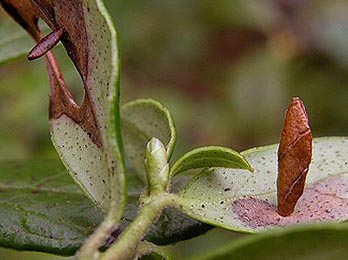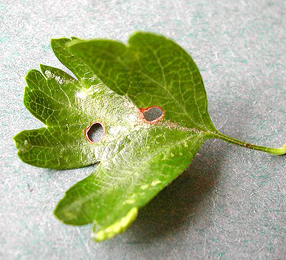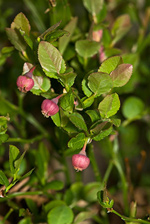|
||||||
|
VACCINIUM. Bilberries. [Ericaceae] |
|
|
Seven species and one hybrid of Vaccinium are recorded in Britain. These include Bilberry (V. myrtillus), Cowberry (V. vitis-idaea) and Bog Bilberry (V. uliginosum). The BSBI provide a downloadable plant crib for Vaccinium. Nine British miners are recorded on Vaccinium. A key to the European miners recorded on Vaccinium is provided in Bladmineerders van Europa. |
|
|
Key for the identification of the known mines of British |
1a > Leaf-miner and case-bearer: The larva lives outside the mine, protected by a case, and feeds on the underlying plant tissues via a hole cut in the epidermis. From that point it eats away as much leaf tissue as it can reach without fully entering the mine. Mine does not contain frass (Coleophora species) |
1b > Leaf-miner, but not a case-bearer: The larva lives mainly inside the mine. Mine usually contains frass. In later instars the larva may live sandwiched between two more or less circular sections cut from the leaf. |
| 2a > Leaf-miner and case-bearer: The full-grown larva in a bivalved composite leaf case, composed of three leaf fragments of increasing age and decreasing size; the case measures c. 10 mm, the mouth angle is c. 60°. Has a two year life cycle and ultimately forms a case of three pieces of mined leaf (British leafminers) |
|
Coleophora idaeella Hofmann, 1869 [Lepidoptera: Coleophoridae]. |
2b > Leaf-miner and case-bearer: A complex life cycle with the larvae initially mining the leaves, before forming a small case in the autumn of the year. The final case is 6-8 mm long and the feeding signs are very visible with the larva being able to leave its case and enter the leaf to feed. The larva begins by making a frass-filled corridor of about 1 cm length; then the corridor widens into a blotch. The larva then cuts an elongated piece of epidermis out out the upper and lower epidermis of this blotch and uses it to construct its first case. In first case (elsewhere already in the mine) it passes its first winter. After hibernation it makes a new case in the same way, and later, after another hibernation, a third one. The case of the full-grown larva is a spathulate leaf case of 6-8 mm, composed of two elongates pieces of epidermis. The case is straight; the rear end is somewhat pointed and bivalved. The mouth angle is 90°. The full depth mines that are made by glitzella often occupy half a leaf, and may contain some frass grains. This is because the lava, after having secured its case with silk on the leaf, often leaves the case altogether and may immerse itself deeply in the mine. |
 Case of Coleophora glitzella on Vaccinium vitis-idaea Image: © Duncan Williams (British leafminers) |
|
Coleophora glitzella Hofmann, 1869 [Lepidoptera: Coleophoridae]. |
2c > Leaf-miner and case-bearer: The fully developed larval case, 6 mm long, on cowberry, in April and May of its second year of life, is easily identified by its structure of about forty discs of leaf arranged like a pile of coins, its walking stick shape and the ventral keel of white silk. Each larva makes a large number of small full depth mines, which can be recognised by the relatively large hole where a disc of leaf has been excised for the case. Greyish black tubular composite leaf case of about 5-6 mm. The case is composed of numerous rings, each cut out of the lower epidermis of the hostplant. The rear end is stromgly curved, like the handle of a walking stick. Mouth angle 45°. |
|
Coleophora vitisella Gregson, 1856 [Lepidoptera: Coleophoridae]. |
3a > Leaf-miner: The young larvae hatch in around August and form a narrow gallery mine in the leaves of cowberry, eventually turning into a blotch in the centre of the leaf, where it pupates in an inflated cavity. Oviposition at the underside of the leaf. The mine begins as a long corridor, with the frass in a broad central line, leaving a clear margin at either side. This gallery abruptly widens into a large full depth blotch, with a central concentration of frass. The full-grown larva makes an exit slit in the lower epidermis, then spins an orange-yellow cocoon within the mine, that is connected with the exit by a silken tunnel. The cocoon causes the leaf to pucker blister-like. |
|
Fomoria weaveri (Stainton, 1855) [Lepidoptera: Nepticulidae]. |
| 3b > Leaf-miner: The larvae mine leaves at first, forming a blotch mine, later descending to the ground in a portable case and feeding on dead leaves. Oviposition is by way of an ovipositor, therefore no egg shell visible. The larva makes a small, roundish, blotch; often several in a leaf. Already after its first moult it makes an excision out of the mine, in size almost equal to the blotch (3-4 mm). Thus sandwiched it drops to the ground and continues feeding on dead leaf material. |
 Mines of Incurvaria masculella Image: © Rob Edmunds (British leafminers) |
|
Incurvaria masculella (Denis & Schiffermüller, 1775) [Lepidoptera: Incurvariidae]. |
3c > Leaf-miner: Oviposition by way of an ovipositor, no egg visible therefore. The larva makes an irregular blotch. The part of the mine nearest to the oviposition site is more thranslucent than the later, in transparancy more greenish, part of the mine. The mine usually lies close to the leaf tip, often several together. After its first moult the larva makes a roundish excision, 3-4 mm in diameter. Incurvaria larvae, while resting, take a horse-shoe like posture, unlike the larvae of Antispila species. Sandwiched herein it drops to the ground and continues feeding of dead leaves. The excision occupies about half of the surface of the blotch. The mine is also described in. |
|
Incurvaria oehlmanniella (Hübner, 1796) [Lepidoptera: Incurvariidae]. |
| 3d > Leaf-miner: The mine on the underside can cause the whole leaf to arch. Mines are most often found on plants low down amongst the heather. Lower-surface tentiform mine, that involves almost the entire leaf. The leaf margins are strongly pulled together, arching the upper surface. Because the leaf tissue of the roof of the mine is incompletely eaten away, this upper surface has got a mottled appearance. |
|
Phyllonorycter junoniella (Zeller, 1846) [Lepidoptera: Gracillariidae]. |
3e > Leaf-miner: A contorted gallery leading to small blotch. Ovipostion at the leaf underside, usually near the midrib. Mine a contorted gallery, often a secondary blotch. Leaf around the mine often turns purple. Frass in a thick central line. Pupation external.. |
|
Stigmella myrtillella (Stainton, 1857) [Lepidoptera: Nepticulidae]. |
| 3f> Leaf-miner: The larva nitially forms mines in the leaf with plentiful dispersed frass. It then leaves the mine and feeds on spun leaves by eating the upper epidermis and parenchyma (see British leafminers). |
| Local and found on hills and mountainsides. |
| Rhopobota ustomaculana (Curtis, 1831) [Lepidoptera: Tortricidae]. |
| Last updated 17-Oct-2019 Brian Pitkin | ||

